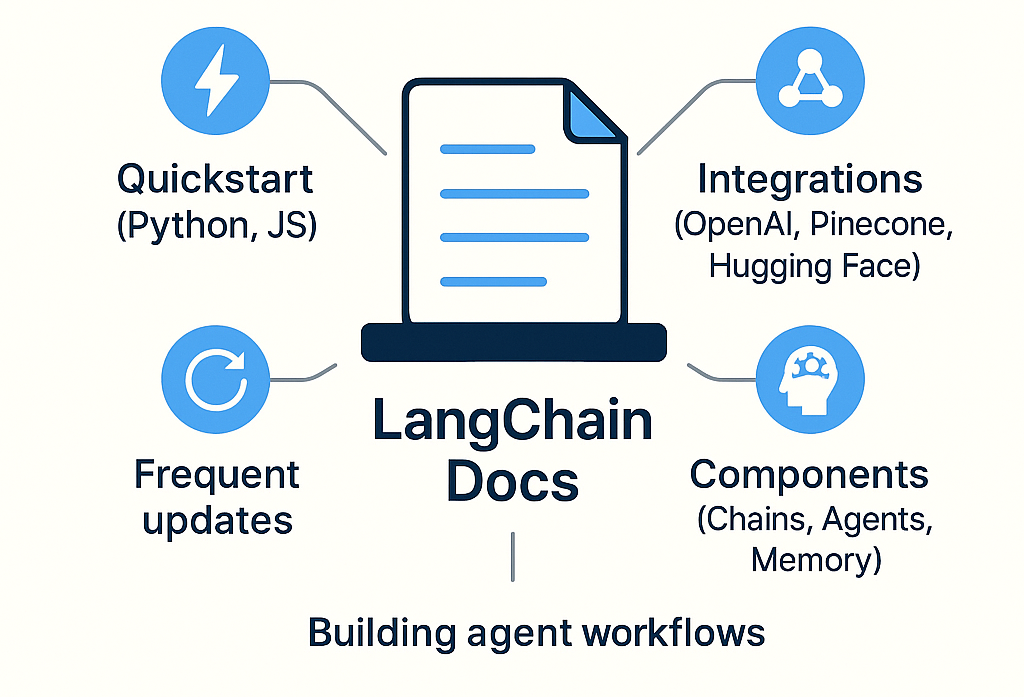Where can I learn LangChain?
LangChain has become a foundational framework for building applications with large language models (LLMs). Whether you're building a retrieval-augmented chatbot, connecting an LLM to external APIs, or designing a custom AI assistant, LangChain gives you the modular components to turn ideas into real systems.
But with its growing complexity and rapid evolution, many developers ask: Where do I actually start? This blog breaks down the most effective ways to learn LangChain, from official docs to hands-on projects, giving you the strategies to go from curious to confident — and fast.
Start with reviewing the LangChain documentation (your foundation)#
The official LangChain documentation is your single most important learning resource. It’s constantly updated, organized by use case, and packed with real examples that reflect how LangChain is used in production.
Why it’s worth your time:
Quickstart guides for Python and JavaScript help you build your first app in minutes.
Example-driven explanations show how components like Chains, Tools, Agents, and Memory connect in real systems.
Integration walkthroughs cover popular services like OpenAI, Hugging Face, and Pinecone; essential if you’re working with embeddings or RAG.
Make it a habit to revisit the docs weekly. LangChain evolves fast, and staying updated here helps you avoid deprecated patterns and unnecessary bugs.
Follow the LangChain blog and YouTube channel#
LangChain’s blog and YouTube channel are where new ideas and real-world workflows get shared. If the docs tell you what’s possible, these platforms show you how it actually looks in production.
Why it matters:
Visual architecture breakdowns make complex flows like multi-agent orchestration much easier to understand.
Release demos help you keep up with new features like LangServe or LangSmith without sifting through changelogs.
Use case spotlights show how developers are applying LangChain to real-world tasks, such as customer support copilots or document retrieval systems.
If you learn best by watching and doing, these resources are invaluable.
Take a hands-on course for structure and projects#
Structured learning helps you move faster, especially when paired with interactive coding.
Top options include:
Educative offers browser-based LangChain courses with embedded code editors. No setup, just learning.
Udemy & Coursera have beginner-to-intermediate courses with full-stack projects like chatbots, RAG apps, and agents.
DeepLearning.AI’s prompt engineering course isn’t LangChain-specific, but it teaches core skills, like prompt design and reasoning, that improve any LangChain build.
Prioritize project-based courses that guide you through building agent flows, retrieval pipelines, or tool integrations.
Use LangChain Hub to learn by remixing#
LangChain Hub is a public repository of chains, prompts, and agents. Think of it as GitHub for LangChain templates — great for learning by doing.
How to get maximum value from it:
Clone and customize an existing chain instead of starting from scratch.
Study real prompt engineering workflows, including few-shot templates and structured chains.
Prototype faster by remixing proven components instead of rebuilding logic every time.
It’s a fast track for learning through iteration and reuse.
Join the community: Discord and GitHub#
LangChain has one of the most active developer communities in the LLM space. If you’re stuck, curious, or scaling, this is where you should go first.
How to get involved:
LangChain Discord gives you real-time help from both core contributors and developers shipping real apps.
GitHub lets you explore example folders, see what others are building, and contribute improvements.
Submit bug reports, suggest docs updates, or share templates to level up while giving back.
The faster you plug into the community, the faster you learn.
Study real-world case studies for context#
LangChain isn’t just for hobby projects. It’s used in production across industries, from finance to education to dev tools.
Key patterns to learn from:
Customer support copilots that use agents + RAG for personalized, multi-turn help.
Document-based search assistants that surface answers from large knowledge bases.
API-integrated agents that fetch live data for tasks like analysis, scheduling, or weather forecasts.
These examples reveal how to think about LangChain as a system, not just isolated components.
Practice with open APIs and datasets#
Building with public data is one of the best ways to apply what you’ve learned.
Starter project ideas:
Wikipedia Q&A bot using LangChain + a vector database (like Chroma or Pinecone)
Recipe or movie recommender that queries open APIs and structures the output
Multi-tool agent that handles math, search, and weather queries with context-aware prompts
As you build, you’ll naturally learn about memory management, prompt templating, and tool orchestration.
Learn from open-source LangChain projects#
Some of the best LangChain code lives on GitHub, built by indie hackers and startups.
What to look for:
Projects tagged “LangChain” or “LLM agent” to find relevant apps
Chain and tool structure: how they build, sequence, and route logic
Memory patterns, especially in chat or multi-turn interfaces
Clone, break, and rebuild. That’s where deep understanding happens.
Watch conference talks and tech meetups#
Sometimes, the fastest way to internalize complex systems is to watch how others build them. LangChain often appears in AI hackathons, online meetups, and conference talks, where teams walk through real-world use cases and deployment challenges.
Why it matters:
Architecture walkthroughs often include trade-offs, edge cases, and failure recovery, which are not always included in tutorials.
Talks from early adopters give insight into how LangChain scales across teams, handles context windows, and integrates with production infrastructure.
Live demos help you visualize and track prompt flow, tool usage, and memory management in real time.
Look for events or talks tagged with “LangChain,” “LLM systems,” or “AI agents.” Prioritize those that go beyond just outputs and focus on why certain design decisions were made.
Pro tip: Take notes during talks and turn them into mini project ideas or implementation experiments.
Track LangChain updates and new tooling#
LangChain evolves quickly. New abstractions like Runnable, and tools like LangServe (for deployment) and LangSmith (for debugging and evaluation) are changing how developers build and manage LLM applications.
How to stay ahead:
Follow LangChain’s GitHub repo and changelogs. Major updates often include deprecations, performance improvements, or new ways to structure chains.
Try bleeding-edge tools in sandbox apps before adopting them in production. This lets you validate benefits without risking regressions.
Watch for integrations with popular services. LangChain regularly expands support for vector DBs, UI frameworks, and cloud providers.
By staying current, you avoid tech debt, discover better abstractions early, and ensure your codebase grows with, not against, the ecosystem.
Teach what you build#
One of the fastest ways to master LangChain is by explaining it. Teaching others forces you to clarify your understanding and expose your own blind spots.
Here’s how to do it effectively:
Write blog posts or developer notes. Share what worked, what didn’t, and how you solved tricky problems. Even a short write-up on connecting LangChain to Pinecone or debugging a RouterChain can help others (and your future self).
Create tutorials or GitHub repos. Turn your LangChain projects into starter kits or walkthroughs. Add comments and READMEs to explain why each decision was made.
Help others on forums and Discord. Answering real questions from new users helps reinforce fundamentals while surfacing use cases you might not have considered.
Bonus: Sharing your work builds visibility in a fast-growing space. It’s good for your resume, your GitHub profile, and your network.
Wrapping up#
LangChain isn’t something you learn passively.
You have to build with it. Every working prototype, no matter how small, teaches you something new about how language models behave, how chains scale, and how tools fit together.
Start here:
Build a simple RAG app with Chroma and OpenAI.
Try chaining a prompt to a calculator tool with memory enabled.
Deploy a mini agent using LangServe and trace its calls with LangSmith.
You don’t need to master the entire framework before starting. You just need to start. And with each project, you’ll build your intuition for modular, composable, production-ready AI systems.
LangChain is how you make LLMs useful. Now’s the time to get your hands on it.
Free Resources

